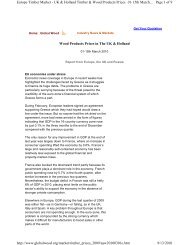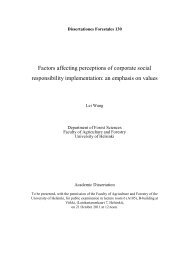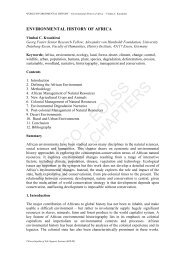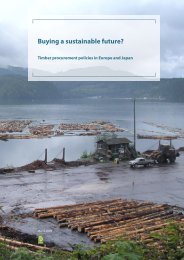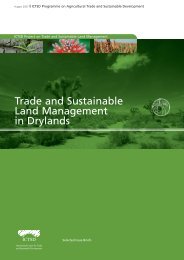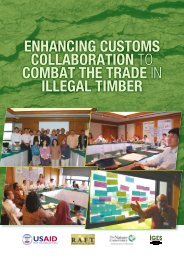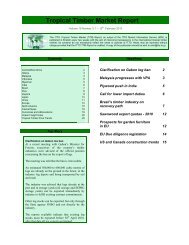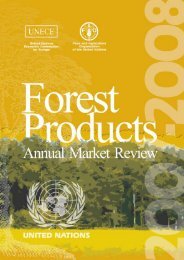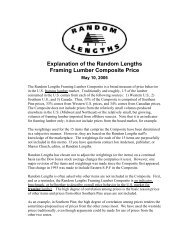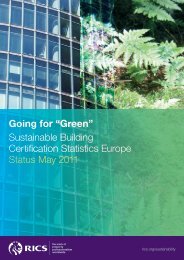ICT and e-Business in the Pulp, Paper and Paper ... - empirica
ICT and e-Business in the Pulp, Paper and Paper ... - empirica
ICT and e-Business in the Pulp, Paper and Paper ... - empirica
Create successful ePaper yourself
Turn your PDF publications into a flip-book with our unique Google optimized e-Paper software.
<strong>Pulp</strong>, paper <strong>and</strong> paper products<br />
<strong>the</strong> RFID-powered SCM <strong>in</strong>formation systems which allow <strong>the</strong> firm to adjust <strong>the</strong>ir<br />
production plann<strong>in</strong>g <strong>and</strong> effectively improved production accuracy. Fur<strong>the</strong>r efficiency<br />
benefits are ga<strong>in</strong>ed by track<strong>in</strong>g manufactur<strong>in</strong>g equipment usage, which has led to <strong>the</strong><br />
elim<strong>in</strong>ation of manufactur<strong>in</strong>g bottlenecks <strong>and</strong> to <strong>the</strong> enabl<strong>in</strong>g of smoo<strong>the</strong>r workflows. In<br />
effect, mach<strong>in</strong>e performance, run times, <strong>and</strong>, consequently, mach<strong>in</strong>e utilization (e.g., of<br />
reels) were optimised.<br />
Critical issues<br />
The company's management identified two critical impact issues: <strong>in</strong>itial <strong>in</strong>vestment costs<br />
<strong>and</strong> problems of manag<strong>in</strong>g <strong>the</strong> large amounts of data. Fur<strong>the</strong>rmore, achiev<strong>in</strong>g <strong>the</strong> full<br />
potential of <strong>the</strong> RFID technology requires costly <strong>in</strong>tegration with exist<strong>in</strong>g enterprise<br />
systems. Moreover, it requires a redesign of bus<strong>in</strong>ess processes <strong>in</strong> all areas of <strong>the</strong> value<br />
cha<strong>in</strong> where <strong>the</strong> technology is used.<br />
In addition, management warned aga<strong>in</strong>st <strong>the</strong> risk that RFID can easily become just<br />
ano<strong>the</strong>r tool for "data collection", while miss<strong>in</strong>g targets <strong>in</strong> terms of its return on <strong>in</strong>vestment.<br />
To avoid this, software applications must be used which can be embedded <strong>in</strong>to<br />
bus<strong>in</strong>ess processes. Only <strong>in</strong> this way can data be translated <strong>in</strong>to managerially useful<br />
<strong>in</strong>formation. The firm claims that it has succeeded <strong>in</strong> meet<strong>in</strong>g this challenge: <strong>the</strong> IT<br />
department successfully delivers useful <strong>in</strong>formation to management.<br />
References <strong>and</strong> acknowledgements<br />
This case study was conducted by Paul Murschetz on behalf of <strong>the</strong> e-<strong>Bus<strong>in</strong>ess</strong> W@tch.<br />
Sources <strong>and</strong> references used:<br />
In March 2006, <strong>the</strong> author conducted two <strong>in</strong>terviews with management representatives<br />
from <strong>the</strong> firm's headquarter <strong>and</strong> with <strong>the</strong> IT consultant / software developer.<br />
4.2.5 Impact on production processes<br />
<strong>ICT</strong> are <strong>in</strong>tensively used to run <strong>and</strong> monitor production processes <strong>in</strong> <strong>the</strong> P&P <strong>in</strong>dustry.<br />
Although production is not among those bus<strong>in</strong>ess areas where companies anticipate <strong>the</strong><br />
most pronounced impact of <strong>ICT</strong> <strong>in</strong> <strong>the</strong> future (see Section 5.1.1, Exhibit 5-6), it is without<br />
any doubt that <strong>the</strong> use of <strong>ICT</strong> is pervasive <strong>in</strong> this context. It is likely that many companies<br />
do no longer perceive this as an area of "<strong>ICT</strong> impact", s<strong>in</strong>ce technology is so deeply<br />
embedded <strong>in</strong> production rout<strong>in</strong>es that it has become a commonplace.<br />
However, <strong>the</strong> most important anticipated impact of <strong>ICT</strong> for <strong>the</strong> future is probably that it<br />
enables companies to better l<strong>in</strong>k production processes with order<strong>in</strong>g <strong>and</strong> logistics<br />
<strong>and</strong>, thus, improve <strong>the</strong>ir supply cha<strong>in</strong>. Fur<strong>the</strong>rmore, <strong>in</strong>telligent systems support quality<br />
control already dur<strong>in</strong>g <strong>the</strong> production process. The follow<strong>in</strong>g case study on Nordic <strong>Paper</strong><br />
demonstrates how <strong>ICT</strong>-based systems can help a company to reduce <strong>the</strong> amount of<br />
products with flaws that are delivered to customers, <strong>and</strong> at <strong>the</strong> same time to optimise <strong>the</strong><br />
quantities of chemicals <strong>in</strong> production. Thus, <strong>the</strong> skilful use of <strong>ICT</strong> could also have a<br />
positive environmental effect.<br />
130



